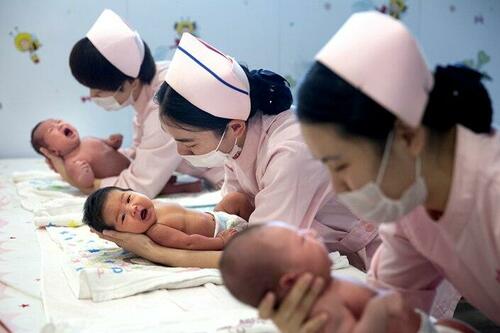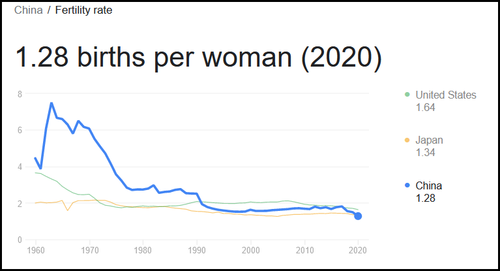
Last month Chinese officials announced that 2022 marked the first drop in total population in six decades, after 9.56 million people were born vs. 10.41 million who died.
Now, the country faces a population decline combined with a long-running rise in life expectancy, which could result in a wide-ranging demographic crisis for the world's second-largest economy.
In order to counter the plummeting fertility rate, Chinese officials have loosened the country's one-child policy, and offered incentives for families to reproduce - but nothing has worked.
Some provinces are trying to go further - including one which now encourages people to have as many babies as they want, even if they are unmarried. In most parts of the country, single mothers are denied government benefits often offered to married couples.
In the tech hub city of Hangzhou, home to Alibaba, the government is now giving parents of a third child 20,000 yuan, or $2,900 as a one-off subsidy. A second child will net parents around $720.
In South China, the city of Wenzhou is planning to offer new parents around $400 in subsidies per child, while the northeastern city of Shenyang is offering up to $72 per month until a child is three years old.
In Shanghai and Shanxi, officials have increased the number of paid marriage leave days - time off granted to couples if they get married - from three days to up to 30 days, according to the People's Daily Health.
The problem, however, is that many young Chinese adults don't want large families, and are pushing back on all sorts of incentives to reproduce in one of the most expensive countries in the world to raise a child, the NY Times reports, noting that "such incentives do little to address anxieties about supporting their aging parents and managing the rising costs of education, housing and health care."
"The fundamental problem is not that people cannot have children, but that they cannot afford it," said 26-year-old Sichuan nurse, Lu Yi, adding that she would need to earn at least double her currently monthly salary of around $1,200 (8,000 yuan) to even consider children.
Many countries around the world — from Japan to Russia to Sweden — have confronted the same demographic challenge, and their attempts to incentivize new babies with subsidies and other tactics have had a limited impact. But China has aged faster than other countries. The often harshly enforced one-child policy, which was aimed at slowing population growth, precipitated the steep decline in births and led to a generational shift in attitudes around family sizes.
Efforts by the ruling Communist Party to raise fertility rates — by permitting all couples to have two children in 2016, then three in 2021 — have struggled to gain traction. The new policy in Sichuan drew widespread attention because it essentially disregards birth limits altogether, showing how the demographic crisis is nudging the party to slowly relinquish its iron grip over the reproductive rights of its citizens. -NY Times
"The two-child policy failed. The three-child policy failed," said University of Wisconsin-Madison researcher, Yi Fuxian, who studies Chinese population trends. "This is the natural next step."
Beijing, we have a problem...
In a 2022 survey of around 20,000 younger Chinese people between the ages of 18 to 25, two-thirds said they don't want children - with demographers suggesting that the pressures and costs associated with the Chinese education system is a major factor. They have suggested things such as shortening schooling by two years, and getting rid of the competitive exam to enter high school.
Meanwhile, with women pressured to step into careers instead of marriage, getting Chinese millennials to overcome issues such as costs might only be the tip of the iceberg when it comes to the current challenge.
"You need to go back to the things that have made marriage rates so low," Professor Stuart Gietel-Basten, who specializes in population policy at the Hong Kong University of Science and Technology, told Insider last year.
"If women are feeling: 'This is such a bad move for my career or my life that I'm going to push it back as long as possible,' then maybe that's a symptom of other challenges, blockages, or malfunctions in society
Last month Chinese officials announced that 2022 marked the first drop in total population in six decades, after 9.56 million people were born vs. 10.41 million who died.
Now, the country faces a population decline combined with a long-running rise in life expectancy, which could result in a wide-ranging demographic crisis for the world’s second-largest economy.
In order to counter the plummeting fertility rate, Chinese officials have loosened the country’s one-child policy, and offered incentives for families to reproduce – but nothing has worked.
Some provinces are trying to go further – including one which now encourages people to have as many babies as they want, even if they are unmarried. In most parts of the country, single mothers are denied government benefits often offered to married couples.
In the tech hub city of Hangzhou, home to Alibaba, the government is now giving parents of a third child 20,000 yuan, or $2,900 as a one-off subsidy. A second child will net parents around $720.
In South China, the city of Wenzhou is planning to offer new parents around $400 in subsidies per child, while the northeastern city of Shenyang is offering up to $72 per month until a child is three years old.
In Shanghai and Shanxi, officials have increased the number of paid marriage leave days – time off granted to couples if they get married – from three days to up to 30 days, according to the People’s Daily Health.
The problem, however, is that many young Chinese adults don’t want large families, and are pushing back on all sorts of incentives to reproduce in one of the most expensive countries in the world to raise a child, the NY Times reports, noting that “such incentives do little to address anxieties about supporting their aging parents and managing the rising costs of education, housing and health care.”
“The fundamental problem is not that people cannot have children, but that they cannot afford it,” said 26-year-old Sichuan nurse, Lu Yi, adding that she would need to earn at least double her currently monthly salary of around $1,200 (8,000 yuan) to even consider children.
Many countries around the world — from Japan to Russia to Sweden — have confronted the same demographic challenge, and their attempts to incentivize new babies with subsidies and other tactics have had a limited impact. But China has aged faster than other countries. The often harshly enforced one-child policy, which was aimed at slowing population growth, precipitated the steep decline in births and led to a generational shift in attitudes around family sizes.
Efforts by the ruling Communist Party to raise fertility rates — by permitting all couples to have two children in 2016, then three in 2021 — have struggled to gain traction. The new policy in Sichuan drew widespread attention because it essentially disregards birth limits altogether, showing how the demographic crisis is nudging the party to slowly relinquish its iron grip over the reproductive rights of its citizens. –NY Times
“The two-child policy failed. The three-child policy failed,” said University of Wisconsin-Madison researcher, Yi Fuxian, who studies Chinese population trends. “This is the natural next step.”
Beijing, we have a problem…
In a 2022 survey of around 20,000 younger Chinese people between the ages of 18 to 25, two-thirds said they don’t want children – with demographers suggesting that the pressures and costs associated with the Chinese education system is a major factor. They have suggested things such as shortening schooling by two years, and getting rid of the competitive exam to enter high school.
Meanwhile, with women pressured to step into careers instead of marriage, getting Chinese millennials to overcome issues such as costs might only be the tip of the iceberg when it comes to the current challenge.
“You need to go back to the things that have made marriage rates so low,” Professor Stuart Gietel-Basten, who specializes in population policy at the Hong Kong University of Science and Technology, told Insider last year.
“If women are feeling: ‘This is such a bad move for my career or my life that I’m going to push it back as long as possible,’ then maybe that’s a symptom of other challenges, blockages, or malfunctions in society
Loading…







